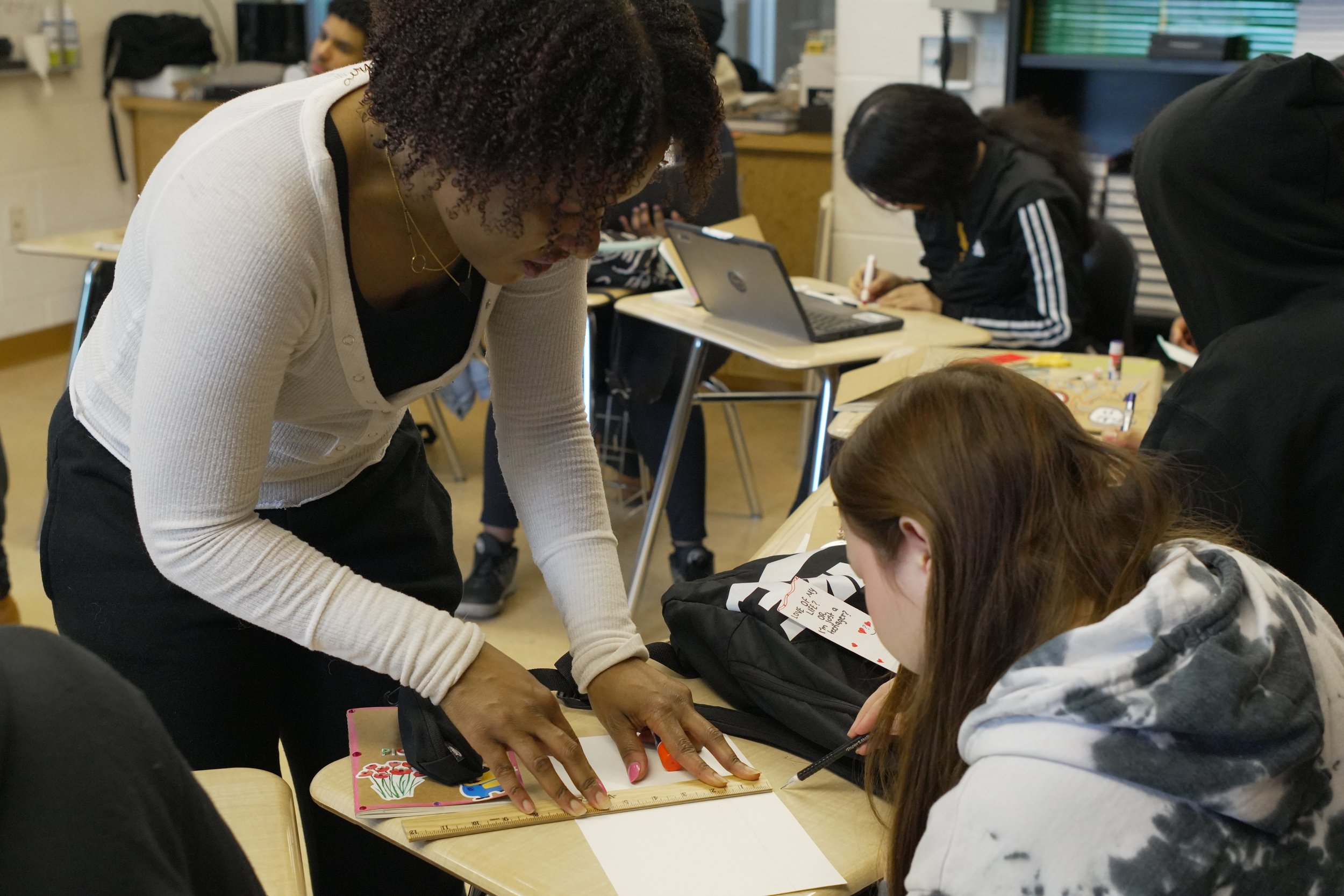Defining and Demystifying Teaching Artistry
By Nella Rohan, ArtWell Staff Writer and Teaching Artist
You've probably heard the saying, "Those who cannot do, teach." I've never liked that because it suggests teaching isn't as valuable as making, which couldn't be further from the truth. And where does that leave those who want to do both?
What exactly do Teaching Artists (TAs) do, and why is their role often misunderstood? Poet and ArtWell TA David Gaines (Dave G.) and I have both had to simplify our titles to avoid confusion, usually saying we facilitate poetry or creative writing workshops. While people might compare TAs to classroom teachers, the roles are quite different in how they're perceived and how they engage with students.
At ArtWell, TAs are at the core of our work, bringing our programs and curriculum to life in classrooms across Philly. In my conversation with fellow TA Dave G, we explore what it means to be a Teaching Artist, the challenges and rewards, and how we balance creating art with teaching it.
What is a Teaching Artist?
Teaching Artists, by definition, balance two careers: working as both an artist and an educator. As the Sierra Arts Foundation describes, they are involved in "discovery, creation, and refinement" in their artistic practice while also guiding students' "lifelong learning in the arts." Dave G., a poet and spoken word artist, is now in his fourth year as a Teaching Artist at ArtWell. He shared his journey: "I fell in love with it, and I'm still here."
Teaching artistry doesn't follow strict mandates, allowing it to remain flexible and more responsive to students' emotional needs. The Teaching Artist Guild (TAG) describes the practice as "mobilizing," "advocating," and centered on "collective action," showing how inherently socially conscious and community-focused teaching artistry is.
Author Eric Booth, in Making Change: Teaching Artists and Their Role in Shaping a Better World, defines a Teaching Artist as "a practicing artist who develops the complementary skills of an educator," engaging participants in meaningful, arts-based learning experiences.
At its core, teaching artistry isn't just about imparting art techniques—it prioritizes fostering a sense of belonging, creating space for individual voices, and using the arts to advocate for personal and societal change. This is especially true at ArtWell, where our TAs embody these principles, helping students build trust and confidence through self-expression.
The Impact of Teaching Artists
At ArtWell, we've seen how arts education, especially for adolescents, offers significant mental and emotional benefits, such as improved trauma processing and stress relief. Teaching Artists create environments where students can build confidence, personal agency, and self-expression through self-directed creativity. These unique opportunities contrast with the structured experiences of traditional schooling, allowing students to express themselves more freely.
Our students have consistently demonstrated growth in their confidence and self-concept through interactions with TAs, who provide mentorship and foster trust and mutual respect. One student recently shared, "I can voice my opinion and say how I feel." Another shared, “I liked ArtWell classes because I learned how to show my artwork without being embarrassed.”
Dave G. adds that Teaching Artists offer a window into "what being a professional artist looks like," showing students that art is a viable career path: "I'm living proof that that's not true," he says in response to the notion that art isn't sustainable.
5 Common Misconceptions about Teaching Artists
Despite their growing presence, there are still common misconceptions about teaching artists and the role they play:
1. TAs are only for schools.
Teaching Artists work in diverse settings, from schools to museums, hospitals, and even prisons.
2. TAs only teach visual art.
They practice art across many fields, including music, dance, theater, and writing.
3. TAs need extensive training.
There is no national certification requirement. TAs often rely on personal experiences, online resources, and community-based curricula, like ArtWell's We the Poets and The Art of Growing Leaders programs.
4. TAs aren’t in the classroom enough to make a difference.
Arts integration can be impactful even with limited time, as seen in our student surveys, which show the significant impact of TAs in short sessions.
5. TAs are art teachers.
While the roles may sound similar, they are distinct. TAs offer a different kind of mentorship that blends artistic practice with education. As Eric Booth points out, teaching artistry is a hybrid role that resists easy categorization but is intentionally both artist and educator, filling a gap traditional education often overlooks.
Opportunities for TAs at ArtWell
At ArtWell, we recognize the unique challenges and rewards of being a teaching artist, which is why we offer ongoing professional development through our Skill Builds series. Held monthly, these workshops are designed to enhance the trauma-informed teaching practices of our TAs and provide stipends for their facilitation. We're also pursuing funding for a Teaching Artist Wellness Fund, focused on supporting the mental and physical well-being of our TAs—something we believe is essential for sustaining their creativity and energy. One of the challenges TAs face is being a part of the gig economy, where they often work as independent contractors and don't have access to healthcare and other benefits.
The Importance of Supporting TAs
As teaching artists, we juggle everything from lesson planning to mentoring while staying true to our artistic practice. We're in the classroom, blending creativity with instruction to create experiences that are not only fun and engaging but also meaningful.
In my time as a high school teacher and now as an ArtWell Teaching Artist, I've seen how much of a difference TAs can make. We help students find their voice and build confidence in ways that traditional schooling doesn't always allow. That's why supporting teaching artists is so important—we play a crucial role in helping students grow creatively and emotionally.
Teaching artists occupy a vital space in education and community development, offering a blend of creativity, mentorship, and social awareness that transforms the learning environment. We're dedicated to supporting ArtWell's incredible educators through initiatives such as ArtWell's Skill Builds and future Wellness Fund as they continue this vital work. Understanding the role and necessity of TAs is essential to knowing how to best support them, from acknowledging their work to advocacy and paying them living wages. Recognizing their impact and supporting TAs is necessary for the future of arts education.
Want to get to know ArtWell’s Teaching Artists? Meet our current cohort!


